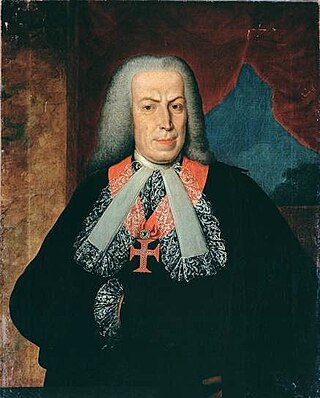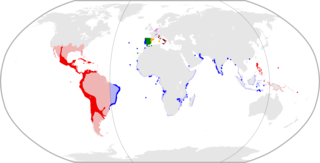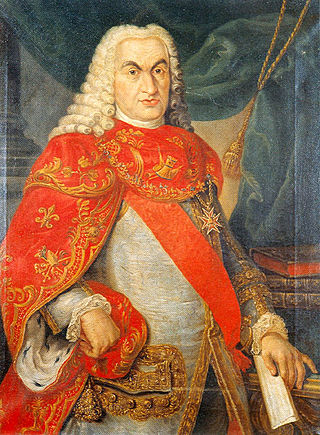Related Research Articles

Ultramontanism is a clerical political conception within the Catholic Church that places strong emphasis on the prerogatives and powers of the Pope. It contrasts with Gallicanism, the belief that popular civil authority—often represented by the monarch's or state's authority—over the Church is comparable to that of the Pope.

The Spanish colonization of the Americas began in 1493 on the Caribbean island of Hispaniola after the initial 1492 voyage of Genoese mariner Christopher Columbus under license from the Queen Isabella I of Castile. These overseas territories of the Spanish Empire were under the jurisdiction of Crown of Castile until the last territory was lost in 1898. Spaniards saw the dense populations of indigenous peoples as an important economic resource and the territory claimed as potentially producing great wealth for individual Spaniards and the crown. Religion played an important role in the Spanish conquest and incorporation of indigenous peoples, bringing them into the Catholic Church peacefully or by force. The crown created civil and religious structures to administer the vast territory. Spanish colonists settled in greatest numbers where there were dense indigenous populations and the existence of valuable resources for extraction.

Early modern Europe, also referred to as the post-medieval period, is the period of European history between the end of the Middle Ages and the beginning of the Industrial Revolution, roughly the late 15th century to the late 18th century. Historians variously mark the beginning of the early modern period with the invention of moveable type printing in the 1450s, the Fall of Constantinople and end of the Hundred Years’ War in 1453, the end of the Wars of the Roses in 1485, the beginning of the High Renaissance in Italy in the 1490s, the end of the Reconquista and subsequent voyages of Christopher Columbus to the Americas in 1492, or the start of the Protestant Reformation in 1517. The precise dates of its end point also vary and are usually linked with either the start of the French Revolution in 1789 or with the more vaguely defined beginning of the Industrial Revolution in late 18th century England.

Charles IV was King of Spain and ruler of the Spanish Empire from 1788 to 1808.

Charles III was King of Spain in the years 1759 to 1788. He also was Duke of Parma and Piacenza, as Charles I (1731–1735); King of Naples, as Charles VII; and King of Sicily, as Charles V (1734–1759). He was the fifth son of Philip V of Spain and the eldest son of Philip's second wife, Elisabeth Farnese. He was a proponent of enlightened absolutism and regalism.

The Spanish Empire, sometimes referred to as the Hispanic Monarchy or the Catholic Monarchy, was a colonial empire governed by Spain between 1492 and 1976. In conjunction with the Portuguese Empire, it was the first empire to usher the European Age of Discovery and achieve a global scale, controlling vast portions of the Americas, Africa, various islands in Asia and Oceania, as well as territory in other parts of Europe. It was one of the most powerful empires of the early modern period, becoming known as "the empire on which the sun never sets". At its peak in 1810, the Spanish Empire covered over 13 million square kilometres, making it one of the largest empires in history.

Sebastião José de Carvalho e Melo, 1st Marquis of Pombal and 1st Count of Oeiras, known as the Marquis of Pombal, was a Portuguese statesman and diplomat who effectively ruled the Portuguese Empire from 1750 to 1777 as chief minister to King Joseph I. A liberal reformer influenced by the Age of Enlightenment, Pombal led Portugal's recovery from the 1755 Lisbon earthquake and modernized the kingdom's administrative, economic, and ecclesiastical institutions. During his lengthy ministerial career, Pombal accumulated and exercised autocratic power.

Spanish America refers to the Spanish territories in the Americas during the Spanish colonization of the Americas. The term "Spanish America" was specifically used during the territories' imperial era between 15th and 19th centuries. To the end of its imperial rule, Spain called its overseas possessions in the Americas and the Philippines "The Indies", an enduring remnant of Columbus's notion that he had reached Asia by sailing west. When these territories reach a high level of importance, the crown established the Council of the Indies in 1524, following the conquest of the Aztec Empire, asserting permanent royal control over its possessions. Regions with dense indigenous populations and sources of mineral wealth attracting Spanish settlers became colonial centers, while those without such resources were peripheral to crown interest. Once regions incorporated into the empire and their importance assessed, overseas possessions came under stronger or weaker crown control.

The suppression of the Society of Jesus was the removal of all members of the Jesuits from most of Western Europe and their respective colonies beginning in 1759 along with the abolition of the order by the Holy See in 1773. The Jesuits were serially expelled from the Portuguese Empire (1759), France (1764), the Two Sicilies, Malta, Parma, the Spanish Empire (1767) and Austria, and Hungary (1782). Political manoeuvrings both in Rome and within each country involved influenced this timeline. The papacy reluctantly acceded to the anti-Jesuit demands of various Catholic kingdoms while providing minimal theological justification for the suppressions.

Bernardo Tanucci was an Italian statesman, who brought an enlightened absolutism style of government to the Kingdom of the Two Sicilies for Charles III and his son Ferdinand IV.
The ideas of the Age of Enlightenment came to Spain in the 18th century with the new Bourbon dynasty, following the death of the last Habsburg monarch, Charles II, in 1700. The period of reform and 'enlightened despotism' under the eighteenth-century Bourbons focused on centralizing and modernizing the Spanish government, and improvement of infrastructure, beginning with the rule of King Charles III and the work of his minister, José Moñino, count of Floridablanca. In the political and economic sphere, the crown implemented a series of changes, collectively known as the Bourbon reforms, which were aimed at making the overseas empire more prosperous to the benefit of Spain.

Zenón de Somodevilla y Bengoechea, 1st Marquess of Ensenada, commonly known as the Marquess of Ensenada, was a Spanish statesman. He played a key role in crafting and enforcing the Great Gypsy Round-up, officially known as the General Imprisonment of the Gypsies, which was an attempt to exterminate the Roma living in Spain, leading to the death of 12,000 Romani People.

The Kingdom of France is the historiographical name or umbrella term given to various political entities of France in the medieval and early modern period. It was one of the most powerful states in Europe since the High Middle Ages. It was also an early colonial power, with colonies in Asia and Africa, and the largest being New France in North America.

The Bourbon Reforms consisted of political and economic changes promulgated by the Spanish Crown under various kings of the House of Bourbon, since 1700, mainly in the 18th century. The beginning of the new Crown's power with clear lines of authority to officials contrasted to the complex system of government that evolved under the Habsburg monarchs. For example, the crown pursued state predominance over the Catholic Church, pushed economic reforms, and placed power solely into the hands of civil officials.

Josephinism is a name given collectively to the domestic policies of Joseph II, Holy Roman Emperor (1765–1790). During the ten years in which Joseph was the sole ruler of the Habsburg monarchy (1780–1790), he attempted to legislate a series of drastic reforms to remodel Austria in the form of what liberals saw as an ideal Enlightened state. This provoked severe resistance from powerful forces within and outside his empire, but ensured that he would be remembered as an "enlightened ruler" by historians from then to the present day.
The patronato system in Spain was the expression of royal patronage controlling major appointments of Church officials and the management of Church revenues, under terms of concordats with the Holy See. The resulting structure of royal power and ecclesiastical privileges, was formative in the Spanish colonial empire. It resulted in a characteristic constant intermingling of trade, politics, and religion. The papacy granted the power of patronage to the monarchs of Spain and Portugal to appoint clerics because the monarchs "were willing to subsidize missionary activities in newly conquered and discovered territories."

The history of the Catholic Church in Mexico dates from the period of the Spanish conquest (1519–21) and has continued as an institution in Mexico into the twenty-first century. Catholicism is one of many major legacies from the Spanish colonial era, the others include Spanish as the nation's language, the Civil Code and Spanish colonial architecture. The Catholic Church was a privileged institution until the mid nineteenth century. It was the sole permissible church in the colonial era and into the early Mexican Republic, following independence in 1821. Following independence, it involved itself directly in politics, including in matters that did not specifically involve the Church.
The ideas of the Spanish Enlightenment, which emphasized reason, science, practicality, clarity rather than obscurantism, and secularism, were transmitted from France to the New World in the eighteenth century, following the establishment of the Bourbon monarchy in Spain. In Spanish America, the ideas of the Enlightenment affected educated elites in major urban centers, especially Mexico City, Lima, and Guatemala, where there were universities founded in the sixteenth and seventeenth centuries. In these centers of learning, American-born Spanish intellectuals were already participants in intellectual and scientific discourse, with Spanish American universities increasingly anti-scholastic and opposed to “untested authority” even before the Spanish Bourbons came to power. The best studied is the University of San Carlos Guatemala, founded in 1676.

The Kingdom of Spain entered a new era with the death of Charles II, the last Spanish Habsburg monarch, who died childless in 1700. The War of the Spanish Succession was fought between proponents of a Bourbon prince, Philip of Anjou, and the Austrian Hapsburg claimant, Archduke Charles. After the wars were ended with the Peace of Utrecht, Philip V's rule began in 1715, although he had to renounce his place in the succession of the French throne.

The secularization movement in the Philippines under Spanish colonial administration from the 18th to late 19th century advocated for greater rights for native Filipino Roman Catholic clergymen. The movement had significant implications to Filipino nationalism and the Philippine Revolution.
References
- ↑ Taylor, William B. Magistrates of the Sacred: Priests and Parishioners in Eighteenth-Century Mexico. Stanford: Stanford University Press 1996, p. 14.
- ↑ Paquette, Gabriel. Enlightenment, governance, and reform in Spain and its empire, 1759-1808. New York: Palgrave Macmillan, 2008, p. 70.
- ↑ Paquette, Enlightenment, Governance, and Reform, pp. 70-71
- ↑ Lynch, John. Bourbon Spain 1700-1808. Blackwell 1989, p. 108.
- ↑ Payne, Stanley G. A History of Spain and Portugal, Madison: University of Wisconsin Press 1973, pp. 355-56.
- ↑ Paquette, Gabriel. Enlightenment, governance, and reform in Spain and its empire, 1759-1808. New York: Palgrave Macmillan, 2008.
- ↑ Lynch, Bourbon Spain, p. 109.
- ↑ Taylor, Magistrates of the Sacred, pp. 14-15; 542
- ↑ Mörner, Magnus. "The expulsion of the Jesuits from Spain and Spanish America in 1767 in light of eighteenth-century regalism." The Americas 23.2 (1966): 156-164.
- ↑ Paquette, Enlightenment, Governance, and Reform, p. 71.